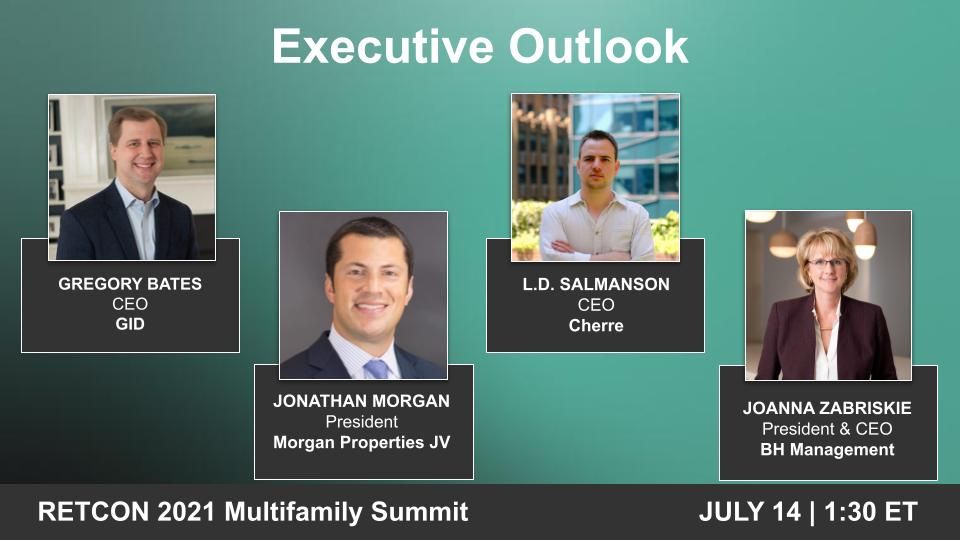
We recently joined RETCON’s July Multifamily Summit for discussions about the latest technology trends and advancements that will impact the multifamily sector. Our CEO, L.D. Salmanson, moderated a panel with Joanna Zabriskie, the President and CEO of BH Management, Jonathan Morgan, the President of Morgan Properties JV, and Gregory Bates, the CEO of GID.
Here are some of our key takeaways on how shifts in technology have created opportunities for multifamily owners, operators, and developers.
Data is already creating opportunities for competitive advantages .
Some companies have already started using data to create competitive advantages, especially on the operational and revenue side of business. For example, BH Management has a group of data scientists in Dallas that is responsible for organizing and visualizing their data. “We pull data from all of our operating systems, and then we turn around and visualize it into a series of dashboards that we think mirror the KPIs we want to see,” said Joanna Zabriskie from BH Management. Automating data entry enabled their team to spend more analyzing their data to support decision making.
Widespread access to data within their organization meant that no one had to chase down an excel sheet or dataset. As access to traditional and new data sources increases across the industry, real advantages will come from leveraging connected data for real-time decision making.
Residents desire technological upgrades in their homes.
Millennials and Gen-Z like to keep up with the latest technology, and a home that isn’t smart won’t suffice. This means that new multifamily buildings with the most up-to-date technology compete better in the market. “The only way to be a Class A over a Class B apartment is if you have class A technology,” said Jonathan Morgan from Morgan Properties JV. In the long-term, residents have many different choices, and technology helps you stand out and seem more appealing. Joanna Zabriskie pointed out, “we have no problem convincing a resident that this is a superior product if you have a smart lock, [smart] thermostat, etc.”
Another trend also shows that many young adults are putting off on buying a home or property and having a baby. This is an elongation of the rental cycle as people buy properties at a later age. It’s not a threat to the multifamily sector, but it does mean that renters will want to be satisfied long-term when it comes to multifamily properties. Therefore, having a long-term approach and focusing on resident retention when developing a multifamily property will be more profitable in the long run, and that includes keeping your building up-to-date, technologically speaking.
First impressions and services are everything.
Before, if a potential resident wanted to tour a home, they would have to take time off of work during the day to attend an open house. Now, those potential residents can access services in real-time and tour a home online whenever it is most convenient for them. Services like this play a big part in the first-impression a resident has with their potential new home. Gregory Bates said that his biggest initiative with GID is their residents’ first experience with them. “Customer self-service is a huge theme and that rolls through everything on the research side, leasing side, and guided tours. It’s a huge first impression.”
Technology makes it easier to take a self-guided tour online and even glance at more options that might be a better fit. If we can decide on a vacation from the reviews online or self-check out at a grocery store, we can definitely find a rental home online as well. The same goes for any other services that require contact such as mobile work orders. Businesses that use technology to streamline and make these services easier, can offer better customer experience and increase retention.
The Pandemic brought technological progress and the chance for adaptation.
Before COVID-19, a lot of time was wasted entering and verifying data, and this left a large margin for error. Although the multifamily segment tends to be “old school”, the pandemic forced the segment to innovate using data. “We spent a lot of time pre-COVID verifying data and making sure we had a single source of truth,” said Joanna Zabriskie. “We cleaned up our work flows. We cleaned up the data entry process and we have a big server now with 20 years of data that we’re able to look back at and look forward to making some predictions.”
During this rapid journey, firms had to update their systems. They were able to give access and visibility to all their employees and investors on current data trends internally and externally. For example, when people struggled to pay rent last year, BH properties could update their payment dashboards to understand at what hour rent payments would come in. With a single-source of truth, everyone is able to understand where they are and where they should be. With this information, companies like Morgan Properties JV were actually a lot more proactive during the pandemic because they could make larger acquisitions with the confidence technology gave.
As the Multifamily segment shifts towards a technology-enabled and data-driven future, it’s important to keep up with the transformation by making changes in your organization, product, and services. Overall, focus on how you can leverage data as a tool and improve as an organization when it comes to analyzing it. Those who use data to their advantage, will be the most successful in the CRE industry.
Watch the full session replay for more insights on the multifamily industry